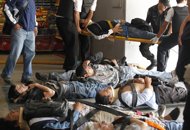49 dead, hundreds injured in Buenos Aires train crash

"The train was full and the impact was tremendous," a passenger identified only as Ezequiel told local television, adding that medics at the scene appeared overwhelmed by the scale of the disaster.
Witnesses said the train's brakes failed as it was arriving at the Once station on the western outskirts of Buenos Aires.
Passengers were hurled on top of each other and knocked to the floor of the train "in the blink of an eye," some losing consciousness and others seriously injured, they said.
"Unfortunately, we must report that there are 49 dead in the accident," including a child, police spokesman Nestor Rodriguez told a news conference.
Civil defense officials said at least 600 people were hurt in the crash, including 200 seriously, making it among the deadliest rail accidents worldwide.
Medevac helicopters landed in the street outside the station to ferry the most seriously wounded to hospitals, as ambulances raced in and out of the area with the injured.
"There were people who were crushed and shouting desperately. I saw bodies and blood all over the place," said Alejandro Velazquez.
Argentine President Cristina Kirchner suspended a news conference on the dispute with Britain over the Falkland Islands following news of the crash.
Transportation Secretary Juan Pablo Schiavi said the train entered the station at a speed of 20 kilometers (12 miles) an hour, and failed to stop, crashing into a retaining wall at the end of the track.
"It was a very serious accident," he said at a news conference. "Cars piled up on top of each other and one them went six meters (yards) inside another car."
At least 30 people were trapped in the twisted wreckage of the first and second carriages, said Alberto Crescenti, the head of the city's emergency services office.
"Inside the first car there was a human wall," said a firefighter who asked not to be identified, likening the scene to that at a 1994 disco fire in which 194 people died heaped inside.
Firefighters and rescue workers had to break through skylights in the train's roofs and cut a path through the wreckage to those trapped inside.
Bodies were hauled out of the wreckage of the first car using a system pulleys, winches and belts, a police spokesman said.
The train's driver was injured but rescue workers pried him loose from the wreckage of his cabin. Local television showed images of him and several people being carried away on stretchers.
"I felt the explosion of the crash. It was very loud," said passenger Pedro Fuentes.
Another passenger, who identified herself as Myriam, said she was with her two children, aged six and four.
"In a blink of an eye we were on the floor. I don't know how we got out. The door crashed in one me, and I covered the girl."
The Sarmiento rail line, owned by private company TBA, links the center of Buenos Aires to a densely populated suburb 70 kilometers (44 miles) to the west of the city and uses rolling stock made in Japan and acquired in the 1960s.
As an investigation opened into the crash, rail workers complained about a lack of investment following the privatization of the rail network in the 1990s.
An employee with the rail line's maintenance department, Monica Slotauer, said "the brakes failed and this is the result of a lack of investment."
Rail unionist Roberto Nunez also complained of "irregularities, deficiencies and a situation limited to the provision of services," speaking on Radio del Plata.
The toll from Wednesday's crash surpassed the city's last major rail disaster just five months ago when two trains and a bus collided during rush hour, killing 11 people and injuring more than 200.
The region's transit system has been plagued with serious accidents in recent years.
In March 2008, 18 people were killed and 47 injured when a bus was hit by a train in Dolores, 212 kilometers (132 miles) south of Buenos Aires.
Argentina's deadliest train tragedy was in 1970, an accident that killed 236 people in northern Buenos Aires.
What the stars mean:
★ Poor ★ ★ Promising ★★★ Good ★★★★ Very good ★★★★★ Exceptional
 Tag:
Tag:
Related Contents
Latest News
More News
- 72 nations sign landmark Hanoi cybercrime convention (October 26, 2025 | 18:00)
- UN Secretary-General commends Vietnam’s global leadership (October 26, 2025 | 09:00)
- APEC finance ministers convene to tackle regional challenges (October 22, 2025 | 17:31)
- Rewiring global trade: ASEAN’s rise as supply chain hub (October 17, 2025 | 11:40)
- Vietnam attends first World Nuclear Week Forum in Russia (September 26, 2025 | 10:50)
- Vietnam attends 69th session of IAEA General Conference (September 16, 2025 | 10:00)
- ADB, WB pledge over 12 billion USD for ASEAN power grid, renewable energy projects (August 15, 2025 | 14:18)
- Lowy Institute proposes AI-based tobacco control solutions for ASEAN (August 15, 2025 | 14:14)
- Cloud computing policy to position Malaysia as regional hub by 2030 (August 15, 2025 | 14:11)
- Thailand, Cambodia suffer numerous cyber attacks (August 05, 2025 | 16:19)























 Mobile Version
Mobile Version